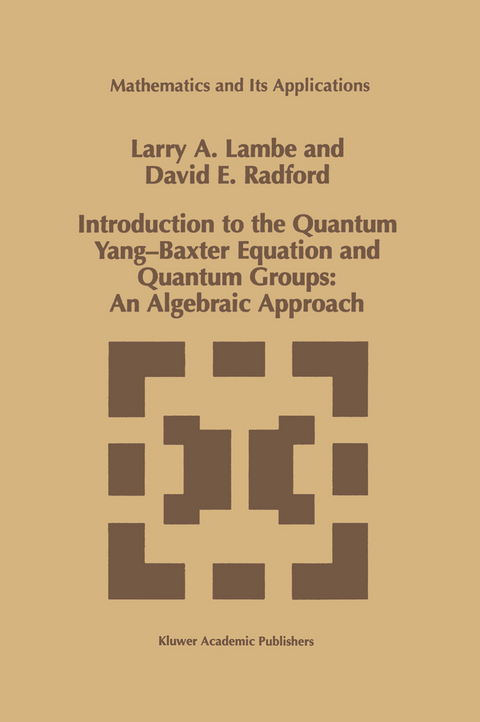
Introduction to the Quantum Yang-Baxter Equation and Quantum Groups: An Algebraic Approach
Seiten
1997
Springer (Verlag)
978-0-7923-4721-7 (ISBN)
Springer (Verlag)
978-0-7923-4721-7 (ISBN)
A systematic treatment of algebras, coalgebras, bialgebras, Hopf algebras, and represen tations of these objects to the extent needed for the book is given. The class of examples described in Chapter 6 in connection with the quantum double consists of pointed Hopf algebras.
Chapter 1 The algebraic prerequisites for the book are covered here and in the appendix. This chapter should be used as reference material and should be consulted as needed. A systematic treatment of algebras, coalgebras, bialgebras, Hopf algebras, and represen tations of these objects to the extent needed for the book is given. The material here not specifically cited can be found for the most part in [Sweedler, 1969] in one form or another, with a few exceptions. A great deal of emphasis is placed on the coalgebra which is the dual of n x n matrices over a field. This is the most basic example of a coalgebra for our purposes and is at the heart of most algebraic constructions described in this book. We have found pointed bialgebras useful in connection with solving the quantum Yang-Baxter equation. For this reason we develop their theory in some detail. The class of examples described in Chapter 6 in connection with the quantum double consists of pointed Hopf algebras. We note the quantized enveloping algebras described Hopf algebras. Thus for many reasons pointed bialgebras are elsewhere are pointed of fundamental interest in the study of the quantum Yang-Baxter equation and objects quantum groups.
Chapter 1 The algebraic prerequisites for the book are covered here and in the appendix. This chapter should be used as reference material and should be consulted as needed. A systematic treatment of algebras, coalgebras, bialgebras, Hopf algebras, and represen tations of these objects to the extent needed for the book is given. The material here not specifically cited can be found for the most part in [Sweedler, 1969] in one form or another, with a few exceptions. A great deal of emphasis is placed on the coalgebra which is the dual of n x n matrices over a field. This is the most basic example of a coalgebra for our purposes and is at the heart of most algebraic constructions described in this book. We have found pointed bialgebras useful in connection with solving the quantum Yang-Baxter equation. For this reason we develop their theory in some detail. The class of examples described in Chapter 6 in connection with the quantum double consists of pointed Hopf algebras. We note the quantized enveloping algebras described Hopf algebras. Thus for many reasons pointed bialgebras are elsewhere are pointed of fundamental interest in the study of the quantum Yang-Baxter equation and objects quantum groups.
Foreword. Preface. Introduction. 1. Algebraic Preliminaries. 2. The Quantum Yang-Baxter Equation (QYBE). 3. Categories of Quantum Yang-Baxter Modules. 4. More on the Bialgebra Associated to the QYBE. 5. The Fundamental Example of a Quantum Group. 6. Quasitriangular Structures and the Double. 7. Coquasitriangular Structures. 8. Some Classes of Solutions. 9. Categorical Constructions. Appendices: A-Prerequisites. A.1. The Ground Ring k and Basic k-Linear Maps. A.2. Algebras, Coalgebras, and Their Representations. A.3. Various Notations Related to the QYBE. A.4. Some Results from Linear Algebra. References. Index.
| Erscheint lt. Verlag | 31.10.1997 |
|---|---|
| Reihe/Serie | Mathematics and Its Applications ; 423 | Mathematics and Its Applications ; 423 |
| Zusatzinfo | XX, 300 p. |
| Verlagsort | Dordrecht |
| Sprache | englisch |
| Maße | 155 x 235 mm |
| Themenwelt | Mathematik / Informatik ► Mathematik ► Algebra |
| Mathematik / Informatik ► Mathematik ► Analysis | |
| Naturwissenschaften ► Physik / Astronomie | |
| ISBN-10 | 0-7923-4721-8 / 0792347218 |
| ISBN-13 | 978-0-7923-4721-7 / 9780792347217 |
| Zustand | Neuware |
| Informationen gemäß Produktsicherheitsverordnung (GPSR) | |
| Haben Sie eine Frage zum Produkt? |
Mehr entdecken
aus dem Bereich
aus dem Bereich
Buch | Softcover (2022)
Springer Spektrum (Verlag)
39,99 €


